
What is the most optimized production system?
- Essence of Manufacturing 4.0 and GLOSCAM -
Category: ICT
Published: 2016
#1715b
Mikio Yotsukura (四倉幹夫)
17z20u/17z25r
Title
What is the most optimized production system?
最適生産とは何か?
Index
Tag
; 5S; ABC analysis; APS; BOM; Bottleneck check process; Cellular manufacturing; CPS; Cycle counting; Defeat of MRP production; GLOSCAM; Industrie 4.0; In-process inventory; Integrated BOM; Kanban system; LLC; M2M; Management issue; MPS; MRP; Order style; PDM & PLM; PMS; POP; Product # system; Pull-type production; SMS; TPS;
Résumé
Remarks
>Top 0. Introduction:
- The essence of Production Management System:
- System for continuous or sustainable production
- About 30K parts are needed to produce a car.
0. 序文:
- 生産管理システムは、持続的に生産を行うためのシステム
>Top 1. Why Production Management is needed?:
- ♥BOM (Bill of Materials) is the most basic database for manufacturing industry.
- BOM is the configuration information hierarchically expressed according to the assembly sequence. (>Fig-1.)
- Reduce the inventory level:
- Inventory is composed of 1) raw material, 2) work in process, and 3) finished product
- The inventory of 'work in process' corresponds to the lead time.
- Cf: Kanban system = JIT inventory management system of Toyota.
- Work in process is increased by efficient production at site.
- Inventory reflects the lead time of the production, or mapping of the lead time form procurement of the material up to delivery of the final product, via work in process.
- Inventory is regarded as sleeping cash in the production cycle.
- Inventory also is composed of affirmative inventory and passive one.
- Thus, to maintain appropriate corporate activities, Inventory Control matters.
- Stocktaking: action or process of recording the amount of the stock
- >Top Inventory and production cycle: (>Fig-2)
- It is not easy to count all items of the inventory.
- Cycle counting: ranking items of the inventory as 1) monthly inventory, 2) intermediate inventory, and 3) end-period inventory: (>Fig-3)
- BTO (Build to Order): =Make to Order; product is not built until a confirmed order for the product is received;
- BTO is considered good for highly configured products as automobiles, bicycle, computer, or aircraft.
- BTO is also common in food service as restaurant.
- Inventory control:
- Unit of inventory is changed by a packing type; by dozen, or by gross (=12 dozens =144 pieces), or by palette (eg. 12 boxes=12×24=288 pieces)
- POP (Point of Production):
- RFID (Radio Frequency Identification)
- BCR (Bar-code reader)
- Kanban, or JIT (Just-In-Time)
- OR (Operations Research)
- ABC Analysis:
- Inventory Management based on supply & demand forecast or sales plan.
- Inventory should be managed continuously along the time axis; historical inventory and future forecast of inventory.
- Inventory should be also managed along space axis; multi-country inventory based on global supply chain.
- Inventory management has two objects; 1) to make cost down, and 2) to avoid loss of order opportunity
- Is Inventory 1) 'an evil' or 2) 'a necessary evil'?
- 1) is passive inventory, and 2) is affirmative inventory.
- or 3) inventory to follow CS (customer satisfaction).
- >Top Thus, Inventory Management is a major management issue, or business challenge; to establish inventory policy.
- Visualization of inventory;
- to synchronize actual stock and book record of the inventory.
- 5S activities (Separation, Sequence, Sweeping, Sanitation, & Schooling) are needed to realize visualization of the inventory; promoted by QC (Quality Control) activities.
- Location management:
- Where the inventory is actually put in the factory?: E.g.:
- Location: 1F floor, lay-flat, xxline rack
- Aisle: 1st pathway
- shelf: left-side shelf
- tray: 1st and 2nd trays
- pallet: a unit portable by a forklift
- lot: 1 dozen, or 100 pieces
- >Top Push-type production: pre-process instructs post-process to prepare for production. <Fig-4>
- Pull-type production: post-process instructs pre-process to prepare for production.
- How to reduce an inventory:
- To produce as much as salable.
- To eliminate waste by visualizing the inventory; visualization +5S
- To produce exactly according to the production schedule.
- To reduce design error and design changes.
- To promote modularization and outsourcing.
- To abridge lead time.
- To abridge lead time:
- Lead time: producing time+preparing time+transporting time+waiting time
- To abridge development lead time; improving time to market.
- Eg: development a new car: from 5 years to 1.5 years.
- Visualization of development process: calling each stage as 'Barrier and Way bill'
- To abridge production lead time
- development time =function time +idle time
- M-M (Man-Machine) chart; which is more bottleneck; standard operation
- 5gen= field, site, product, principle, discipline
- Simultaneous engineering
- To abridge procurement lead time
- cooperation of business partners is indispensable; partial procurement, small lot, multiple suppliers, on-time delivery
- Cost down:
- To know the cost price: by visualization of cost
- Chronological BOM:
- VA (Value Analysis)
- Mass production: by
- standardized parts
- subdivided process by belt conveyor
- MRP (Material Requirements Planning); IMB "COPICS" in 1970s.
- unsuitable for large item small scale production system; flexible manufacturing
- Lower cost mass production by emerging economies, such as TV, semiconductor, mobile phone, PC, LCD, etc.
- Very few version up of MRP system in the last 20 years.
- Present ERP was made referring MRP system:
1. なぜ生産管理が必要か?:
- ♥部品表 (BOM): 製造業のための最も基本的なデータベース
- 組立順序に応じて階層的に表現した構成情報
- BOM of a fan: (Fig-1)
in-house product and outsourced product (redbox)
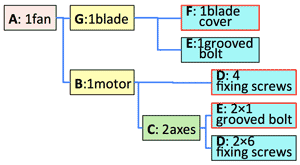
- Inventory & Production Cycle: (Fig-2)
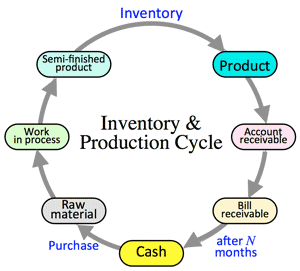
- Cycle counting (循環棚卸): (Fig-3)
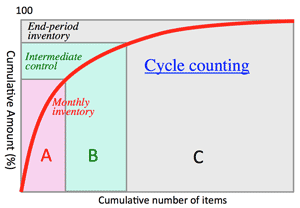
- Inventory:<L. inventarium 詳細目録, a list of what was found <L. venire=to come
- 5S (分類整理, 整列整頓, 清掃, 衛生清潔, 調教躾)
- Push型生産・Pull型生産: (Fig-4)
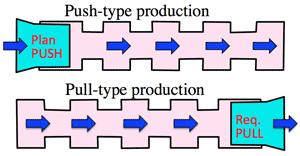
- 在庫削減方法:
- 売る分しか作らない
- 見える化によってムダを省く
- 生産計画に基づ正確な生産
- 設計ミス・設計変更を減らす
- モジュール化・外注化の推進
- リードタイムの短縮
- リードタイムを短縮する
- リードタイム=加工時間+段取時間+移動時間+待ち時間
- 開発リードタイム削減
Function Time + Idel Time
- 生産リードタイム削減
- 調達リードタイム削減
- コストダウン:
>Top 2. MRP system sustained mass production:
- MPS (Master Production Schedule):
- Eg: To make the item-A, 2 parts of item-B, 2 part of item-C, and a part of item-D should be prepared.
- Here, A is an independent requirement, where B/C/D are dependent requirements.
- Process of MRP calculation: >Fig.
- MRP (Martial Requirements Planning)=MPS (Master Production Schedule; Production planning)+BOM: >Fig-1
- →Inventory Transition Table → Placing order of parts/materials + Product instruction
- Standardization of parts: JIS standard
- Subdivision of production process:
- Less change of planning:
- Product-A= Part-B (2) + Part-C(1) + Part-D(2)
- Independent product= Dependent part-B (2pcs), Dependent-part-C (1pc), ....
- Orders:
- Order of Planning:
- Order of Parts/Materials (Outsource):
- Order of Production:
- From MRP to CRP: >Fig-2
- Production Plan (PP)
- Master Production Schedule (MPS) ⇔ Rough Cut Capacity Planning (RCCP)
- Material Requirements Planning
- Capacity Requirements Planning
- Leveling → return to MPS
- >Top BOM in RDB: Treatment of BOM in RDB are follows:
BOM is more structured by the concept of PDM (Product Data Management) and PLM (Product Lifecycle Management)
- Single-level Explosion:
- A parent item relates to a child items; like a tree structure.
- Indented Explosion:
- A parent item relates to all layers of children items.
- Summarized Explosion:
- A parent item relates to the numbers of children items.
- Single-level Implosion:
- A child item relates to the parent items
- Indented Implosion:
- A child item relates to all parents items.
- Summarized Implosion:
- A child item relates to all parents items in quantities; this shows how many product is made by a certain material.
- >Top LLC (Low Level Code); Low level item: >Fig-3
- Product-A uses the item-C at level-1 and level-2, while product-X uses the item-C at level-3; thus the LLC of the item-C (the common part) is level-3.
- The lowest level is almost less than level-20 at the lowest.
- TOC (Theory of Constraints: by Eliyahu M. Goldratt
- Bottleneck Check Process: >Fig-4
- Rough Cut MRP, Kanban Process (JIT) System, and TOC are all designed to minimize bottleneck process in production system; each checking process is different.
2. 大量生産を支えたMRP:
- MRP (資材所要量計画)の誕生
- 部品の標準化
- 生産プロセスの細分化
- 少ない設計変更
- MRP計算過程 (Fig-1)
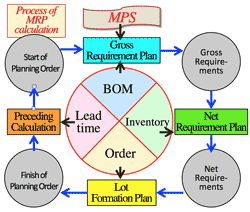
- MRP+BOMから在庫推移表作成
→部品・材料の発注+生産指示 (Fig-2)
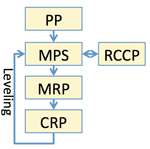
- BOMと部品展開:
- 品目マスタ (Item master)
- 構成マスタ (Structure master)
- 部品表のRDBでの展開:
1990年からPDMとPLMで統合化
- 単層展開
- 構造展開
- 総合展開
- 逆炭層展開
- 逆構造展開
- 逆総合展開
- ローレベルコード (LLC) (Fig-3)
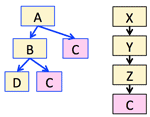
- ボトルネック工程: (Fig-4)
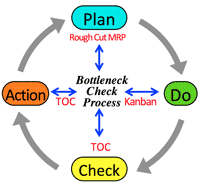
>Top 3. Present industry surrounding BOM:
- All global manufacturers need to construct global engineer chain, because their R&D are domestic, while their production are overseas.
- They are urged to establish global strategic products to gain the market share.
- Particularly, the function of BOM is reviews considering shorter product life cycles; BOM is getting as an essential communication infrastructure among global factories.
- Another factor is 'cloud computing', where BOM is available anywhere.
- CAD (Computer Aided Design) and Product Management are firstly computerized.;
- then PDM (Product Data Management) is needed according to the increase of CAD design.
- then PLM (Product Lifecycle Management) is used by integrating PDM and E-BOM.
- >Top PMS (Production Management System):
Function of Integrated BOM: >Fig-1.
- Integrated BOM is aimed to integrate Designing and Production, which include the function of PDM and PLM.
- Product Lifecycle and BOM:

- Large manufacturer has systems of Sales, CAD, PDM, Procurement, Product Management.; but these systems are not integrated yet.
- Total optimization by an integrated BOM: >Fig-2.
- >Top The most optimized PMS - Toyota JIT (Kanban) System:
- TPS (Toyota Production System):
Kanban system = Business practice connected with flow of parts/product:
- Unique Pull-type PMS:
- This is a mechanism that post-process instructs production of pre-process (post-process pulls pre-process by the pulling-kanban (sign).
- Established by Taiichi Ohno, EVP of Toyota.
- MRP/Order #/Hybrid Production: >Fig-3
- A001/A002: Product # system (≒Order # system)
- All production scenario of PMS is described in BOM.
- What is the integrated BOM?; including concept of time and place:
this integrated BOM can function as communication tool among divisions.
- Conventional MRP BOM
- Product # system (≒Order # system)
- Design sheet and other artifacts documents.
- Process for production, procurement route, and logistics route
- View of designing, production, procurement, and sales & marketing.
- This integrated BOM could be available by changeable VIEW of RDBM (after Oracle 7.3)
- Each division can use this integrated BOM by filtering of own VIEW.
- >Top Cellular Manufacturing System: independent real-time production management.
- Multiple-track planning, and Single-track production: >Fig-4
- Manufacturing 4.0 aims to integrate batch production and real-time production.
- having monthly or weekly activity plan (batch system), which could be daily changeable (real-time system)
- Multiple-track in planing stage, and single-track in production stage.
- >Top APS (Advanced Planning & Scheduling)
- Revise MRP by seat reservation: >Fig-5
- Various scheduling: >Fig-6
- Forward scheduling: (Push-type production) :
- pursue the earliest delivery time by considering lead time of parts.; same as MRP
- Advantage:
- earliest delivery
- surer delivery even in case of troubles.
- Disadvantage:
- weaker in responding change of orders after getting the order.
- maximum in-process inventory
- Backward scheduling: (Pull-type production like Kanban System)
- pursue the latest start of production time by considering the delivery.
- Advantage:
- stronger in responding change of orders
- minimum in-process inventory
- Disadvantage:
- may cause delay of delivery due to some troubles (like procurement)
- >Top Squeeze scheduling:
- Calculate forward scheduling, then recalculate
by backward scheduling; utilizing the latest delivery required by the customer; which may reduce in-process inventory.
- Forward, then backward scheduling:
- Advantage:
- Keep the earliest delivery.
- Delayed procurement of the parts.
- minimize in-process inventory.
- Cut-in scheduling: utilizing additional cellular production.
- >Top Japanese unique Product # system (≒Order # system):
- The Product # system connects all parts.
- Advantage:
- easier Job Order Costing, or ABC analysis for more precise cost calculation.
- Recently, store 80-90% of common parts as in-process inventory; and fully customized the remain 10-20% of unique parts.
- Industrie 4.0, promoted in Germany, seems similar concept of such hybrid production system.
- Because mass production by present MRP system could not compete with emerging economy such as China.
- Quality of product is surely an advantage which advanced economy can make; but the value of quality would be recognized after using it for a while.
- How the Industrie 4.0 could connect the ordered product and the customer, unless using such Product # system.
- >Top Concept of Industrie 4.0:
- Flexible connection among processes or machines or corporations using IoT (Internet of Things) and M2M (Machine to Machine) technologies.
- Smart factory: by integrating or connecting PMS and dynamic cellular production.
- Mass customization: by connecting various factories.
- Standardization: production combining various modules.
- CPS (Cyber Physical System): by integrating cyber space on Internet and physical space of real world.
- Question:
- present BOM of MRP system has only item # of parts, having no means of connecting a particular customer.
- Delivery of parts should be adjusted considering status of the pre-process.
- One by one control of inventory of parts, which are connected to the Product % of a certain customer.
- >Top Direct order from BOM: >Fig-7
- Production Management should evolve to maximize value of the products; otherwise the industries of advanced countries could not compete with those of emerging countries.
- Production Management based on more BOM than drawings is essential.
- It is essential that the product # can connect each customer; which is useful to respond to each PL or case of recall.
- In Toyota's case, SMS (Specification Management System) can follow the vehicles (Chassis # from xxx to xxx)
3. 部品表を取り巻く現在の製造業:
- Global SCM = BOM + Cloud
- 統合化部品表: Fig-1.
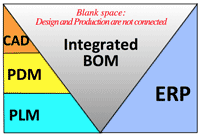
- ←Fig. 製品ライフサイクルと部品表
- 統合化部品表による全体最適: Fig-2
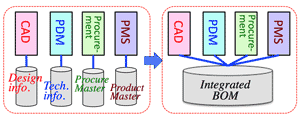
- トヨタ生産方式 (かんばん方式):
- Pull型生産管理:
仕掛かんばん+ 引取かんばん
- 後工程から(引取かんばんで)
引張るシステム
- 後工程以上の製造能力以上のモノを前工程が作れない仕組み
- MRP生産/製番生産/反見込半受注生産: (Fig-3)
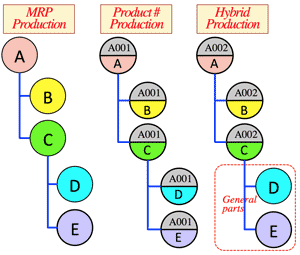
- 計画系は複線,実行形は単線: (Fig-4)
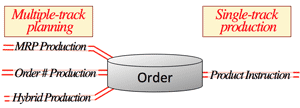
- 座席予約方式による納期回答
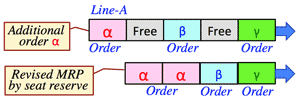
- 様々なスケジューリング方式 (Fig-6)
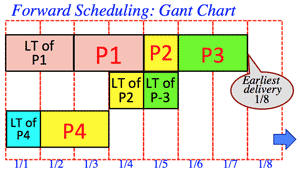
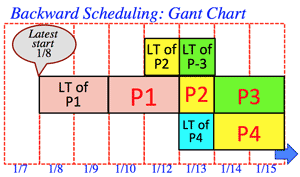
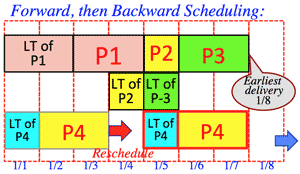
- 部品表から直接オーダ生成:
製番A001/Aを10個作成
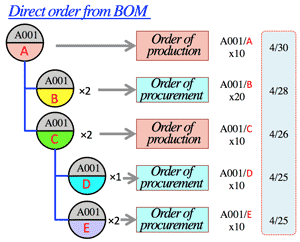
>Top Order style
- Getting order and production schedule:
Order style
Design
Order
material
Accept
material
Fabricate
material
Accept
in process
inventory
Final
assembly
Accept
product
Delivery
to shop
Customer
accepts
Installation
delivery site
ETO 受注設計生産
DP
MTO 受注生産
DP
BTO 受注加工組立
DP
CTO 受注仕様組立
DP
ATO 受注組立
DP
MTS 見込生産
DP
STS 在庫販売
DP
- ETO (Engineering to Order); MTO (Make to Order); BTO (Build to Order); CTO (Configure to Order); ATO (Assemble to Order); MTS (Make to Stock); STS (Stock to Sales)
- The above pink colored zone: Investment based of order estimate.
>Top 4. System for the most optimized production:
- Standardization matters in even 'mass customizaion.'
- How to respond to each customer with combination of 70-90% of in-process inventory.
- How to make new designing and satisfy the customer using 10-30% of customizaion.
- Less standardized production needs more time for production, which may cause delay of delivery.
- The essence is how to make effectively in-process inventory.
- It is important to inherit the past experience, and to extend it to the future. (APS, Advanced Production & Scheduling)
- >Top Improvement of conventional separated BOM's into the integrated BOM is difficult; which may cost about several ten billion yen in case of automobile manufacturers.
- It is the theme of 21C for advanced countries to realized mass customizaion.
- Japanese industries have lost competitiveness in such areas as ship building, PC, semiconductor, mobile phone, TV, home electronics, steel, etc.
- Any emerging countries could catch up to make the high-end products by using latest production equipment, utilizing their competitive labor skills. (Defeat of MRP production)
4. 最適生産を実現するシステム:
- Mass customizationでも標準化は重要
- 如何に70-90%の中間在庫によって顧客の注文に応えるか
- カスタマイズは10-30%に留める
- 如何に効率よく中間在庫を製造するか
- 従来の分断されたBOMから統合化BOMを作るか
- 先進国は、MRP生産方式の敗北
>Top 5. GLOSCAM for global production:
- GLOSCAM (Global Supply Chain Advanced Management); which is not only 'Supply Chain' plus 'Management', but 'Advanced' means managing flows of Labor, Goods, and Fund.
- Management of flow of humans is particularly important.
- Hitherto global production could not manage global staff.
- In addition, chronological management is important.
5. グローバル生産に対応したGLOSCAM:
- マス・カスタマイゼーションの実現
- 人の流れの管理が重要
- 時系列の管理も重要
Comment
- Establishment of ’Integrated BOM' is the key to success in Industrie 4.0 competition.; I-BOMB is destructive, but I-BOM is creative.
- It is also essential to promote clean and less energy and sustainable society to acquire customer satisfaction.
- Industrie 4.0競争の成功への鍵は如何に統合化BOMを確立するか。I-BOMBは破壊的でが、I-BOMは創造的である。
- 同時に、クリーン&省エネルギー、持続社会の推進は顧客満足を得るためには必須。
What is the most optimized production system?- Essence of Manufacturing 4.0 and GLOSCAM -
|
Category: ICT |
|
Mikio Yotsukura (四倉幹夫) |
17z20u/17z25r |
Title |
What is the most optimized production system? |
最適生産とは何か? |
|---|---|---|
Index |
||
Tag |
; 5S; ABC analysis; APS; BOM; Bottleneck check process; Cellular manufacturing; CPS; Cycle counting; Defeat of MRP production; GLOSCAM; Industrie 4.0; In-process inventory; Integrated BOM; Kanban system; LLC; M2M; Management issue; MPS; MRP; Order style; PDM & PLM; PMS; POP; Product # system; Pull-type production; SMS; TPS; | |
Résumé |
Remarks |
>Top 0. Introduction:
|
0. 序文:
|
>Top 1. Why Production Management is needed?:
|
1. なぜ生産管理が必要か?:
|
>Top 2. MRP system sustained mass production:
|
2. 大量生産を支えたMRP:
|
>Top 3. Present industry surrounding BOM:
|
3. 部品表を取り巻く現在の製造業:
|
>Top Order style
|
|||||||||||||||||||||||||||||||||||||||||||||||||||||||||||||||||||||||||||||||||||||||||
>Top 4. System for the most optimized production:
|
4. 最適生産を実現するシステム:
|
||||||||||||||||||||||||||||||||||||||||||||||||||||||||||||||||||||||||||||||||||||||||
>Top 5. GLOSCAM for global production:
|
5. グローバル生産に対応したGLOSCAM:
|
Comment |
|
|